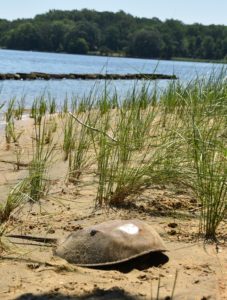Living Shorelines Restoration
The Problem:
The natural shorelines of our local rivers have been largely replaced with stone rip-rap walls and wooden bulkheads to protect property from eroding away from waves by storms and power boats.
These walls offer almost no habitat for aquatic life and reflect the wave energy, making erosion worse for nearby neighbors. They also offer no flood absorption. The small beaches, downed trees, and shoreline grasses that dot a natural shoreline provide protection from predators, and nursery habitat for many species, like fish, terrapins, muskrats, and horseshoe crabs.
The walls act to disconnect the land from the water, and many species, like turtles and muskrats, require a gradual transition to shore.
 To the extent possible, Arundel Rivers wants to replace stone rip-rap walls and wooden bulkheads with natural “living shoreline”. These projects are a natural alternative to fully armoring a shoreline. They provide shoreline stabilization and erosion control by strategically placing stones to work with wave energy on the rivers and creeks.
To the extent possible, Arundel Rivers wants to replace stone rip-rap walls and wooden bulkheads with natural “living shoreline”. These projects are a natural alternative to fully armoring a shoreline. They provide shoreline stabilization and erosion control by strategically placing stones to work with wave energy on the rivers and creeks.